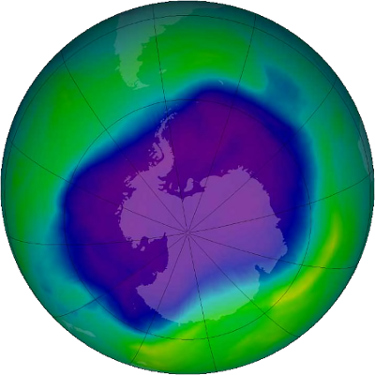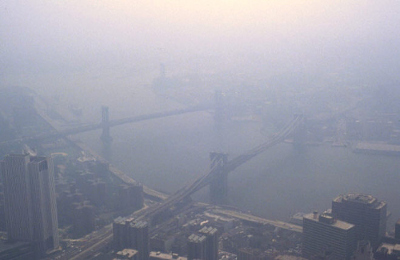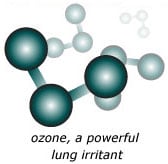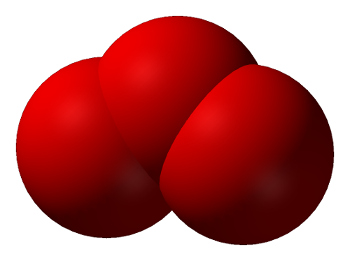Ozone (03) is a gas and is a very active form of oxygen that is produced in the atmosphere when 3 atoms of oxygen are combined. Ozone is found in two different and divergent locations – up high in the stratosphere and down low in the troposphere. While both of these molecules are the same, the location of them makes a big difference in how they impact our health.
Stratospheric Ozone
Stratospheric ozone serves to shield the Earth against biologically damaging, ultraviolet radiation from the sun. Most of us are familiar with this type of ozone due to the slowly healing “hole” in the ozone layer. The use of chlorofluorocarbons (CFCs) largely created a thinning in the ozone layer, but as tightened restrictions of CFCs went into effect, we are beginning to see a restoration of that layer.
Tropospheric Ozone AKA Ground Level Ozone
Ground-level ozone is different, in not only its impact on our health but also its origins. Ground level ozone is a secondary pollutant, which means it is not emitted directly into the atmosphere but is actually created when primary pollutants react with each. This type is created by a photochemical reaction involving elements known as ozone precursors. Specifically hydrocarbons, referred to as volatile organic compounds (VOCs), and oxides of nitrogen (NOx) react in the sunlight to form this type of ozone. Warm temperatures stimulate this reaction, which is the reason that the highest ozone levels typically occur during the warmest times of the year. Motorized vehicle exhaust, industrial emissions, incomplete combustion, gasoline vapors, and chemical solvents are some of the major sources of these ozone precursors.
 Ground level ozone is a major health and environmental concern and is a primary ingredient of smog, the pollution that blankets many urban areas during the summer. While it’s convenient to think of this as an urban problem, even rural areas are subject to increased ozone levels. Wind carries ozone and the pollutants that create it hundreds of miles away from their original sources and in turn generates air pollution over a wide area. Topography also plays a critical role in where ozone concentrations can be high. This is partly why the air quality in Beijing is so poor, the surrounding area effectively creates a bowl around the city.
Ground level ozone is a major health and environmental concern and is a primary ingredient of smog, the pollution that blankets many urban areas during the summer. While it’s convenient to think of this as an urban problem, even rural areas are subject to increased ozone levels. Wind carries ozone and the pollutants that create it hundreds of miles away from their original sources and in turn generates air pollution over a wide area. Topography also plays a critical role in where ozone concentrations can be high. This is partly why the air quality in Beijing is so poor, the surrounding area effectively creates a bowl around the city.
Health Concerns of Ground Level Ozone
Ozone reacts quickly and strongly with living tissues, plant-derived fabrics, dyes, rubber and many other man-made materials. Ozone oxidizes and destroys organic matter and when inhaled it can react with the lung tissue creating acute inflammation or damage to the lungs. As a secondary effect, it can weaken the immune system making people more susceptible to respiratory illnesses such as bronchitis or pneumonia. Of particular concern is the fact that ozone primarily injures the bronchioles (the smaller airways) and the alveoli (the tiny air sacs that send oxygen into the blood stream).
 The Environmental Protection Agency (EPA) states that “relatively low amounts can cause chest pain, coughing, shortness of breath, and throat irritation. Ozone may also worsen chronic respiratory diseases such as asthma and compromise the ability of the body to fight respiratory infections.”
The Environmental Protection Agency (EPA) states that “relatively low amounts can cause chest pain, coughing, shortness of breath, and throat irritation. Ozone may also worsen chronic respiratory diseases such as asthma and compromise the ability of the body to fight respiratory infections.”
Peoples reactions to ozone pollution vary from individual to individual. Children, the elderly, people with existing lung disease, including asthma, chronic bronchitis, and emphysema and people who exercise outdoors a lot, are at a greater risk from high ozone levels. Ozone can irritate the nose and airways of people with allergies and can increase the allergy symptoms. People with asthma have more asthma attacks when ozone levels are high. One study found a 28 percent increase in emergency room visits for asthma when ozone levels reach even moderate levels. Unfortunately, frequent exposure to ozone pollution may cause permanent damage to the lungs.
Ozone and Air Purifiers
Ion generators and ozone generators create charged particles (ions) and emit them into the surrounding air. These ions combine with impurities (like dust) in the air, forcing the impurities to cling to a nearby surface. Consequently, ion generators often produce dirty spots on nearby walls and floors because they do not eliminate impurities; ion generators simply force impurities to precipitate out of the air and cling to a surface (in the same way that static electricity can make a sock cling to a shirt).
 Ozone generating “air purifiers” were commonly used in the past, and you can still find them in use in flood remediation sites. This type of device uses electrical current to ionize ozone particles in the air, creating O3. As we discusses before, ozone is a powerful oxidizing agent, and this is how it is effective in cleaning the air. The ozone oxidizes particles like mold or bacteria, destroying them.
Ozone generating “air purifiers” were commonly used in the past, and you can still find them in use in flood remediation sites. This type of device uses electrical current to ionize ozone particles in the air, creating O3. As we discusses before, ozone is a powerful oxidizing agent, and this is how it is effective in cleaning the air. The ozone oxidizes particles like mold or bacteria, destroying them.
Both of these devices emit ozone, a powerful lung irritant that can lead to asthma at elevated levels. Not only do they emit ozone, but ion generators are not effective as air cleaners. The EPA tells us: “Available scientific evidence shows that, at concentrations that do not exceed public health standards, ozone is generally ineffective in controlling indoor air pollution.” The EPA advises the public to “use proven methods of controlling indoor air pollution,” which include eliminating or controlling pollutant sources, increasing outdoor air ventilation, and using proven methods of air cleaning. So while ozone may help to destroy microbes, as a general air filtration technology, it is poor at best and outright harmful at worst.
The American Lung Association (ALA) agrees that “ozone is a potent lung irritant and exposure to elevated levels is a contributor to the exacerbation of lung disease; it is especially dangerous for persons with asthma and other chronic lung diseases, children, and the elderly.”
The ALA does not suggest the use of ozone generators because “ozone generators, negative ion generators, and certain other electronic air cleaners that are not listed by the FDA, or cannot otherwise prove that their ozone emission levels are lower than 0.05 ppm, may produce levels of ozone recognized as unsafe for humans and are not recommended for use in occupied spaces because of the risk of generation of ozone.”
Consumer Reports (1992), the National Institute of Occupational Safety and Health (1995), and the U.S. EPA (1995) concluded that tabletop and room unit ozone generators are not effective in improving indoor air quality.
Ozone and Electrical Devices
We often get questions about air purifiers and whether or not they produce ozone. The simple answer is this, “NO air purifier that you will find on the AchooAllergy.com site uses ozone as a means of filtration. Further, all air purifiers on the site are CARB certified and do not produce any harmful levels of ozone.” Now, to explain that. The fact of the matter is that if a device uses electric, it produces some level of ozone. The reaction of electrical current with ambient oxygen creates ozone, which is why many people associate ozone with lightening and the smell of the air after a storm. This means that your toaster, your refrigerator, your television, and even your cell phone, all emit some amount of ozone.
The EPA and CARB (California Air Resource Board) set out guidelines as to what is considered a safe amount of ozone. For years the CARB restriction on ozone was even more stringent than the federal, EPA, standard. As of October 2015, the EPA lowered their acceptable threshold from 0.075 PPM to 0.070 PPM of ozone in an average eight hour period, putting it in line with the CARB standard.
So, the more nuanced answer to the question of whether an air purifier will produce ozone is, yes, but. While the fan has a motor that uses electric, an air purifier that is CARB certified will produce no more ozone than the limit listed above. More simply put, if the minute amount of ozone produced by the home appliances you use and are around every day do not bother you, neither will any of the air purifiers you find on the AchooAllergy.com site.
Shop all of our non ozone emitting air purifiers or learn more in our informative Air Purifier Buying Guide.
